2016 MERCEDES-BENZ GL reset
[x] Cancel search: resetPage 105 of 462
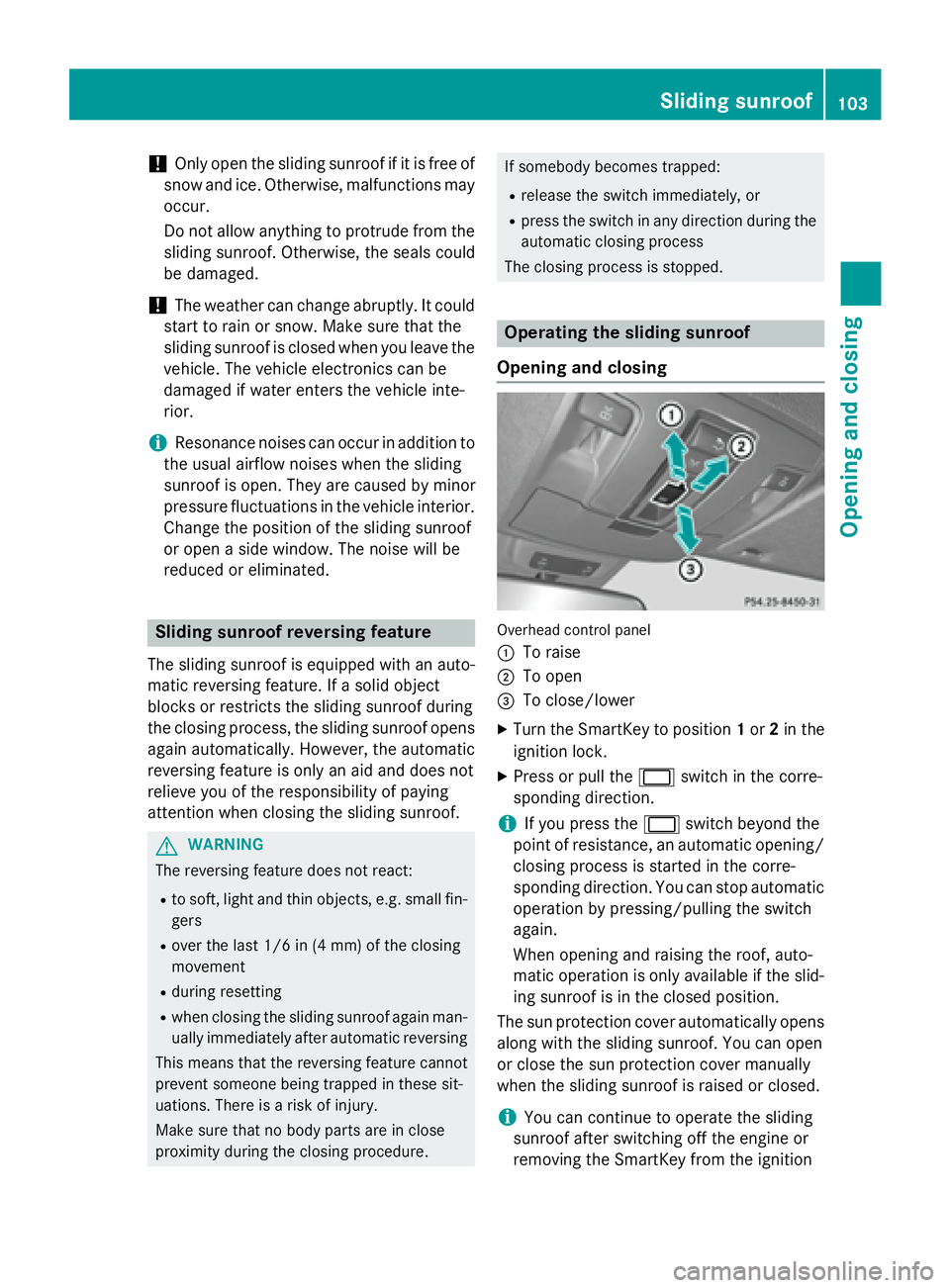
! Only open the sliding sunroof if it is free of
snow and ice. Otherwise, malfunctions may
occur.
Do not allow anything to protrude from the
sliding sunroof. Otherwise, the seals could
be damaged.
! The weather can change abruptly. It could
start to rain or snow. Make sure that the
sliding sunroof is closed when you leave the
vehicle. The vehicle electronics can be
damaged if water enters the vehicle inte-
rior.
i Resonance noises can occur in addition to
the usual airflow noises when the sliding
sunroof is open. They are caused by minor
pressure fluctuations in the vehicle interior.
Change the position of the sliding sunroof
or open a side window. The noise will be
reduced or eliminated.
Sliding sunroof reversing feature The sliding sunroof is equipped with an auto-
matic reversing feature. If a solid object
blocks or restricts the sliding sunroof during
the closing process, the sliding sunroof opens
again automatically. However, the automatic
reversing feature is only an aid and does not
relieve you of the responsibility of paying
attention when closing the sliding sunroof.
G WARNING
The reversing feature does not react: R
to soft, light and thin objects, e.g. small fin-
gers R
over the last 1/6 in (4 mm) of the closing
movement R
during resetting R
when closing the sliding sunroof again man-
ually immediately after automatic reversing
This means that the reversing feature cannot
prevent someone being trapped in these sit-
uations. There is a risk of injury.
Make sure that no body parts are in close
proximity during the closing procedure. If somebody becomes trapped: R
release the switch immediately, or R
press the switch in any direction during the
automatic closing process
The closing process is stopped.
Operating the sliding sunroof
Opening and closing
Overhead control panel
�C
To raise �D
To open �
Page 106 of 462
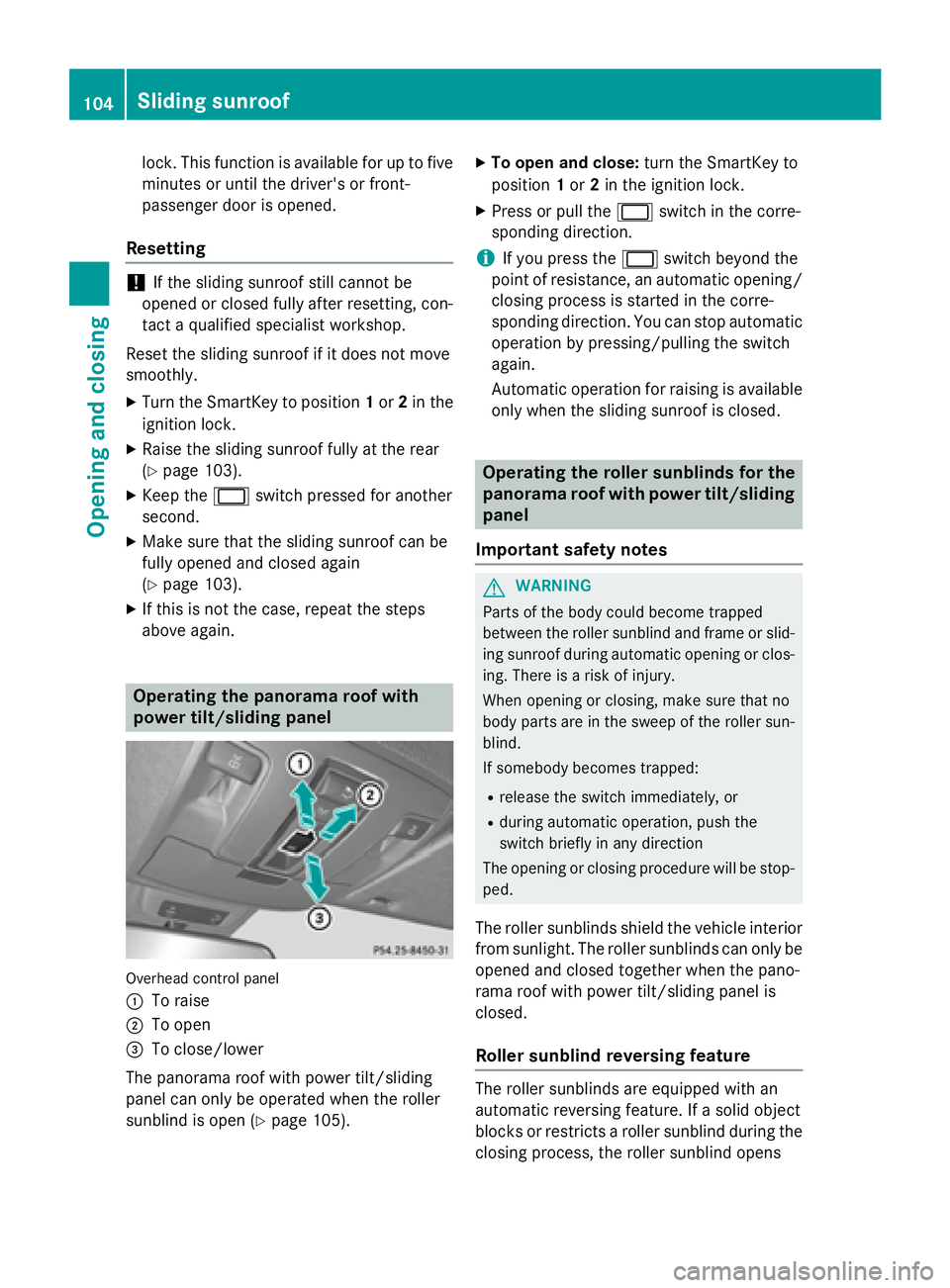
lock. This function is available for up to five
minutes or until the driver's or front-
passenger door is opened.
Resetting
! If the sliding sunroof still cannot be
opened or closed fully after resetting, con-
tact a qualified specialist workshop.
Reset the sliding sunroof if it does not move
smoothly. X
Turn the SmartKey to position 1 or 2 in the
ignition lock. X
Raise the sliding sunroof fully at the rear
( Y
page 103). X
Keep the �V switch pressed for another
second. X
Make sure that the sliding sunroof can be
fully opened and closed again
( Y
page 103). X
If this is not the case, repeat the steps
above again.
Operating the panorama roof with
power tilt/sliding panel
Overhead control panel
�C
To raise�D
To open�
Page 108 of 462
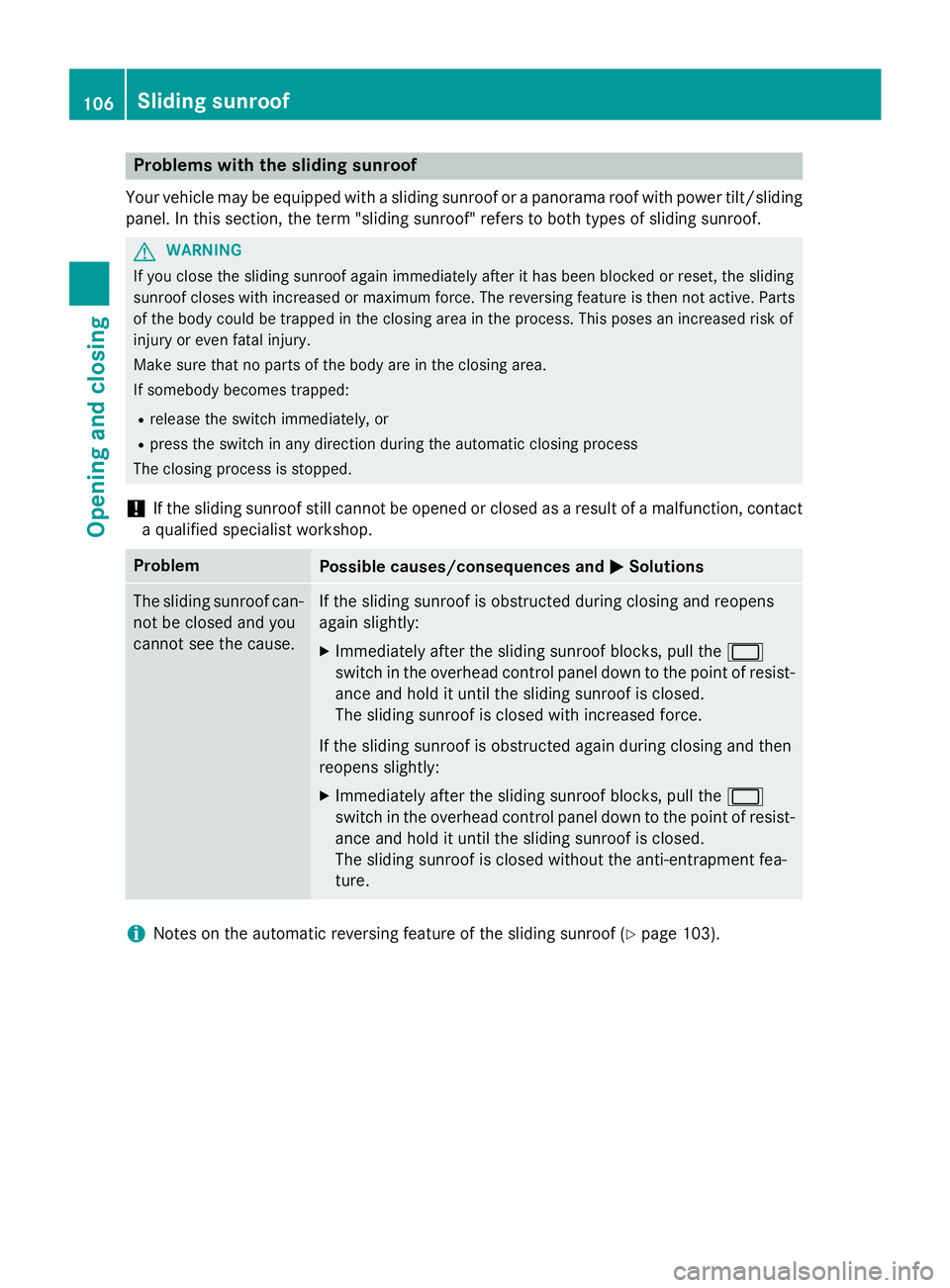
Problems with the sliding sunroofYour vehicle may be equipped with a sliding sunroof or a panorama roof with power tilt/sliding
panel. In this section, the term "sliding sunroof" refers to both types of sliding sunroof.
G WARNING
If you close the sliding sunroof again immediately after it has been blocked or reset, the sliding
sunroof closes with increased or maximum force. The reversing feature is then not active. Parts
of the body could be trapped in the closing area in the process. This poses an increased risk of
injury or even fatal injury.
Make sure that no parts of the body are in the closing area.
If somebody becomes trapped: R
release the switch immediately, or R
press the switch in any direction during the automatic closing process
The closing process is stopped.
! If the sliding sunroof still cannot be opened or closed as a result of a malfunction, contact
a qualified specialist workshop.
Problem
Possible causes/consequences and �P Solutions
The sliding sunroof can-
not be closed and you
cannot see the cause. If the sliding sunroof is obstructed during closing and reopens
again slightly: X
Immediately after the sliding sunroof blocks, pull the �V
switch in the overhead control panel down to the point of resist-
ance and hold it until the sliding sunroof is closed.
The sliding sunroof is closed with increased force.
If the sliding sunroof is obstructed again during closing and then
reopens slightly: X
Immediately after the sliding sunroof blocks, pull the �V
switch in the overhead control panel down to the point of resist-
ance and hold it until the sliding sunroof is closed.
The sliding sunroof is closed without the anti-entrapment fea-
ture.
i Notes on the automatic reversing feature of the sliding sunroof ( Y
page 103).106
Sliding sunroof
Opening and closing
Page 196 of 462
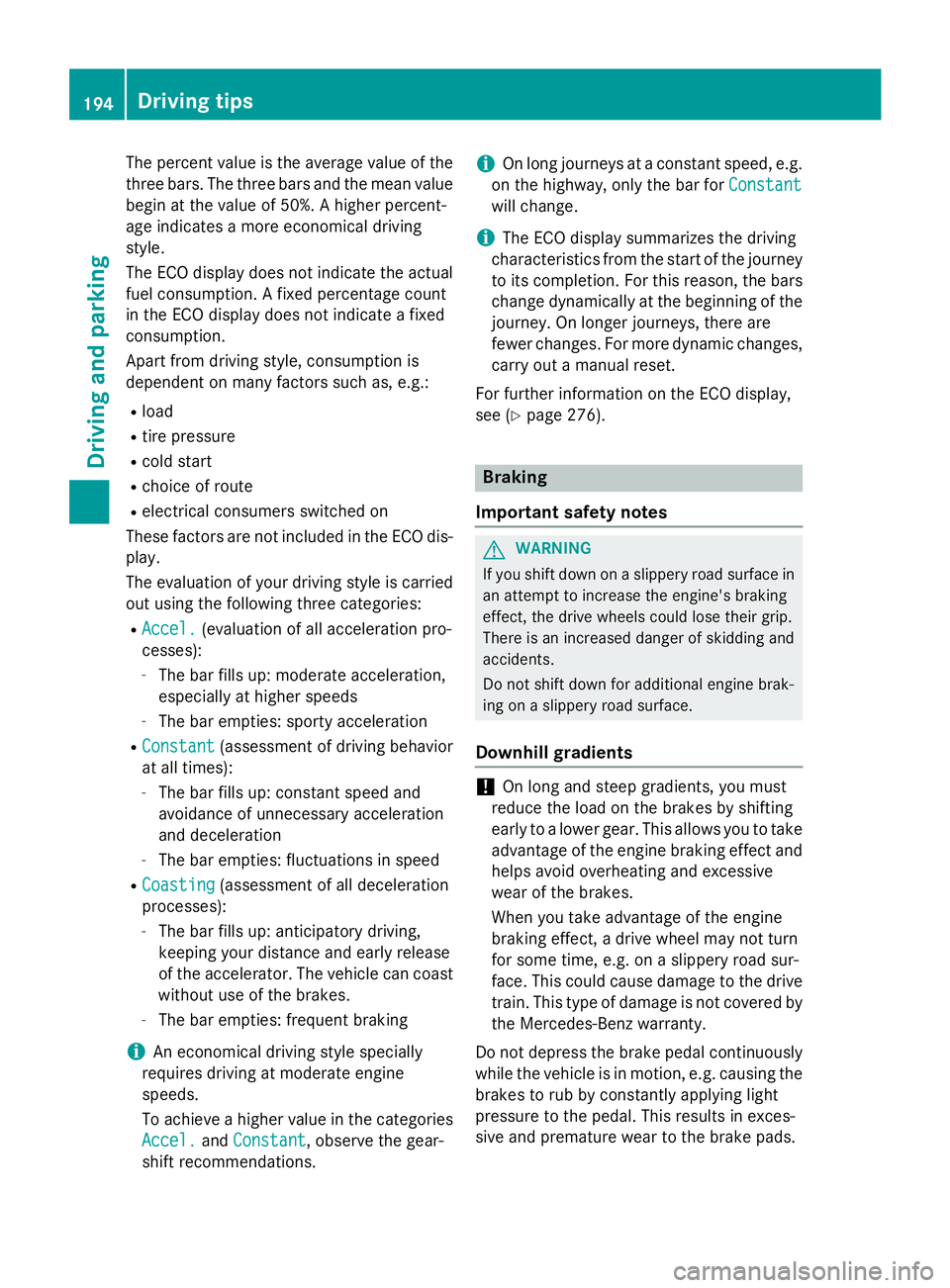
The percent value is the average value of the
three bars. The three bars and the mean value
begin at the value of 50%. A higher percent-
age indicates a more economical driving
style.
The ECO display does not indicate the actual
fuel consumption. A fixed percentage count
in the ECO display does not indicate a fixed
consumption.
Apart from driving style, consumption is
dependent on many factors such as, e.g.: R
load R
tire pressure R
cold start R
choice of route R
electrical consumers switched on
These factors are not included in the ECO dis-
play.
The evaluation of your driving style is carried
out using the following three categories: R
Accel. (evaluation of all acceleration pro-
cesses): -
The bar fills up: moderate acceleration,
especially at higher speeds -
The bar empties: sporty acceleration R
Constant (assessment of driving behavior
at all times): -
The bar fills up: constant speed and
avoidance of unnecessary acceleration
and deceleration -
The bar empties: fluctuations in speed R
Coasting (assessment of all deceleration
processes): -
The bar fills up: anticipatory driving,
keeping your distance and early release
of the accelerator. The vehicle can coast
without use of the brakes. -
The bar empties: frequent braking
i An economical driving style specially
requires driving at moderate engine
speeds.
To achieve a higher value in the categories
Accel.
and Constant , observe the gear-
shift recommendations. i On long journeys at a constant speed, e.g.
on the highway, only the bar for Constant
will change.
i The ECO display summarizes the driving
characteristics from the start of the journey
to its completion. For this reason, the bars
change dynamically at the beginning of the
journey. On longer journeys, there are
fewer changes. For more dynamic changes,
carry out a manual reset.
For further information on the ECO display,
see ( Y
page 276).
Braking
Important safety notes
G WARNING
If you shift down on a slippery road surface in
an attempt to increase the engine's braking
effect, the drive wheels could lose their grip.
There is an increased danger of skidding and
accidents.
Do not shift down for additional engine brak-
ing on a slippery road surface.
Downhill gradients
! On long and steep gradients, you must
reduce the load on the brakes by shifting
early to a lower gear. This allows you to take
advantage of the engine braking effect and
helps avoid overheating and excessive
wear of the brakes.
When you take advantage of the engine
braking effect, a drive wheel may not turn
for some time, e.g. on a slippery road sur-
face. This could cause damage to the drive
train. This type of damage is not covered by
the Mercedes-Benz warranty.
Do not depress the brake pedal continuously
while the vehicle is in motion, e.g. causing the
brakes to rub by constantly applying light
pressure to the pedal. This results in exces-
sive and premature wear to the brake pads.194
Driving tips
Driving and parking
Page 278 of 462
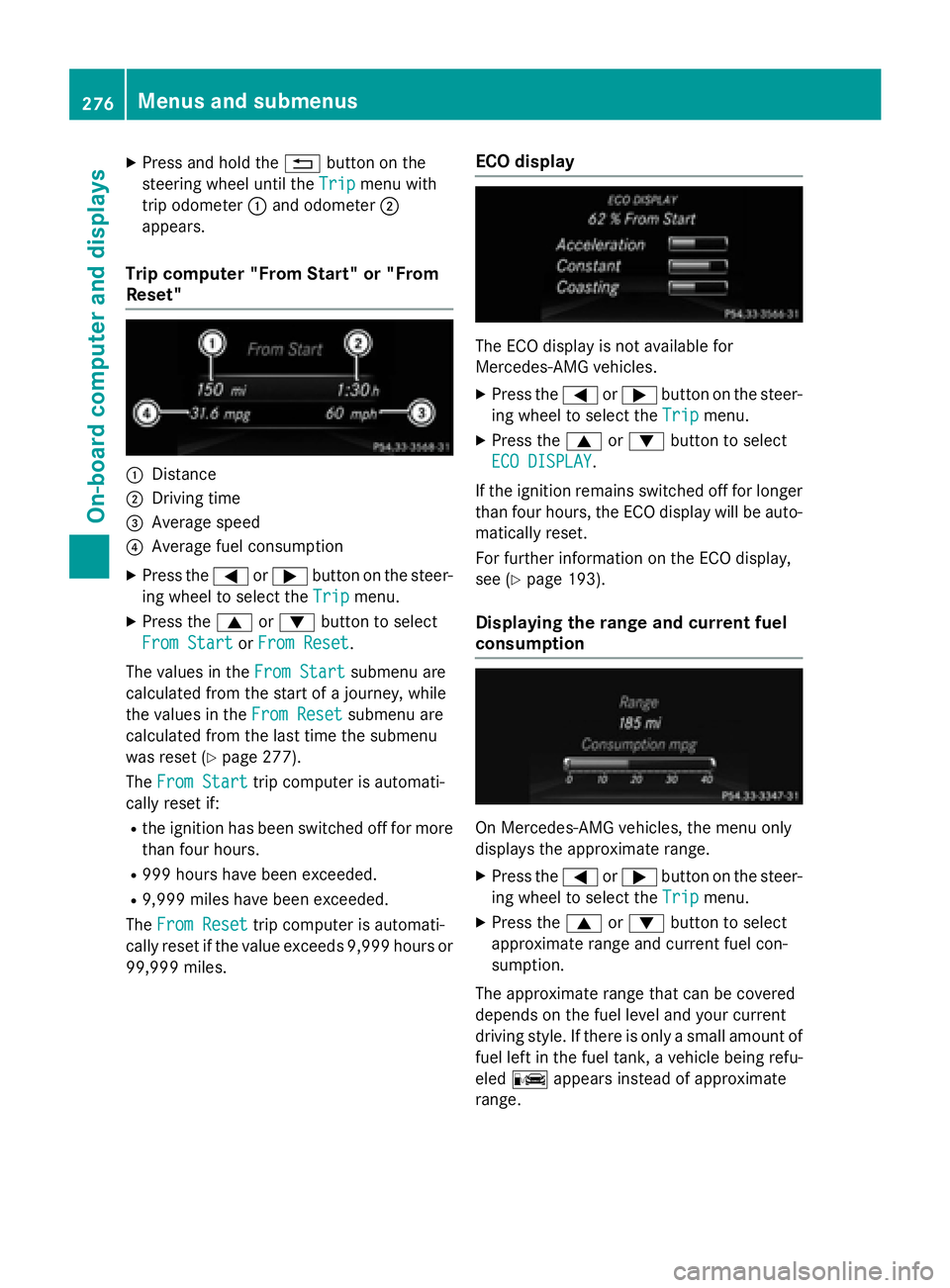
X
Press and hold the �8 button on the
steering wheel until the Trip
menu with
trip odometer �C and odometer �D
appears.
Trip computer "From Start" or "From
Reset"
�C
Distance�D
Driving time�
Page 281 of 462
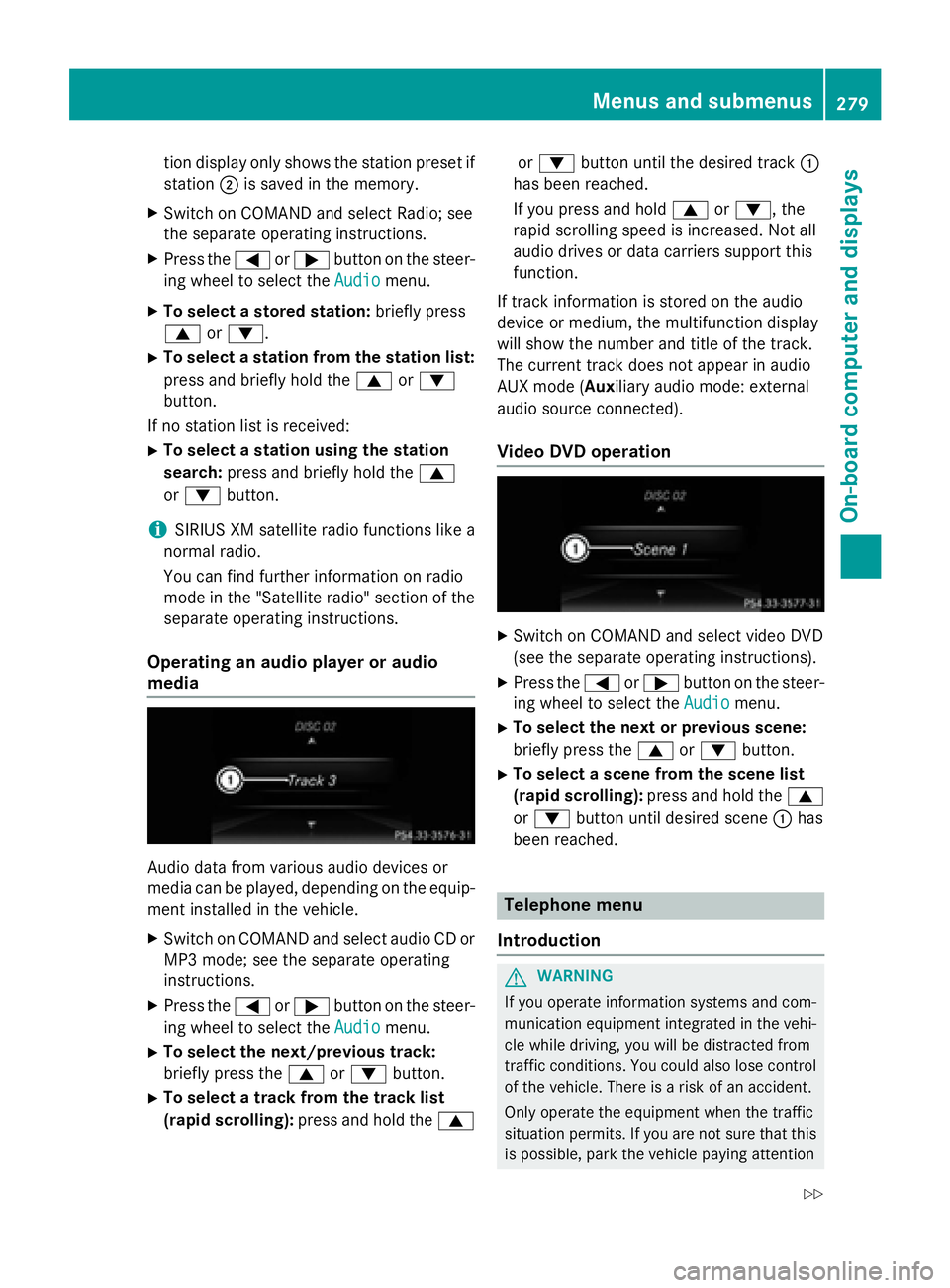
tion display only shows the station preset if
station �D is saved in the memory.X
Switch on COMAND and select Radio; see
the separate operating instructions. X
Press the �Y or �e button on the steer-
ing wheel to select the Audio
menu.X
To select a stored station: briefly press
�c or �d .X
To select a station from the station list:
press and briefly hold the �c or �d
button.
If no station list is received: X
To select a station using the station
search: press and briefly hold the �c
or �d button.
i SIRIUS XM satellite radio functions like a
normal radio.
You can find further information on radio
mode in the "Satellite radio" section of the
separate operating instructions.
Operating an audio player or audio
media
Audio data from various audio devices or
media can be played, depending on the equip-
ment installed in the vehicle. X
Switch on COMAND and select audio CD or
MP3 mode; see the separate operating
instructions. X
Press the �Y or �e button on the steer-
ing wheel to select the Audio
menu.X
To select the next/previous track:
briefly press the �c or �d button.X
To select a track from the track list
(rapid scrolling): press and hold the �c or �d button until the desired track �C
has been reached.
If you press and hold �c or �d , the
rapid scrolling speed is increased. Not all
audio drives or data carriers support this
function.
If track information is stored on the audio
device or medium, the multifunction display
will show the number and title of the track.
The current track does not appear in audio
AUX mode ( Aux iliary audio mode: external
audio source connected).
Video DVD operation X
Switch on COMAND and select video DVD
(see the separate operating instructions). X
Press the �Y or �e button on the steer-
ing wheel to select the Audio
menu.X
To select the next or previous scene:
briefly press the �c or �d button.X
To select a scene from the scene list
(rapid scrolling): press and hold the �c
or �d button until desired scene �C has
been reached.
Telephone menu
Introduction
G WARNING
If you operate information systems and com-
munication equipment integrated in the vehi-
cle while driving, you will be distracted from
traffic conditions. You could also lose control
of the vehicle. There is a risk of an accident.
Only operate the equipment when the traffic
situation permits. If you are not sure that this
is possible, park the vehicle paying attentionMenus and submenus 279
On-board computer and displays Z
Page 289 of 462
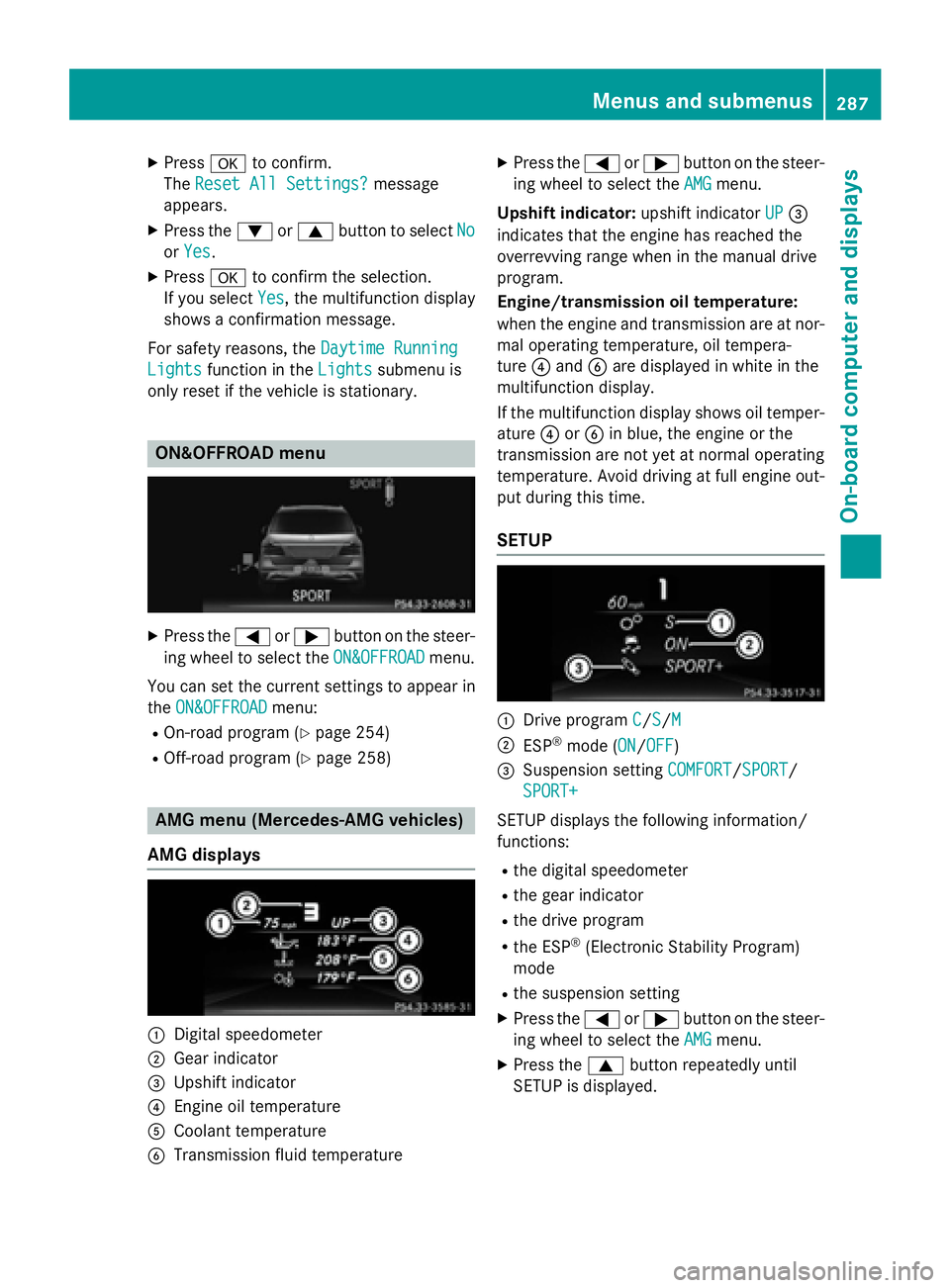
X
Press �v to confirm.
The Reset All Settings?
message
appears. X
Press the �d or �c button to select No
or Yes .X
Press �v to confirm the selection.
If you select Yes
, the multifunction display
shows a confirmation message.
For safety reasons, the Daytime Running
Lights function in the Lights submenu is
only reset if the vehicle is stationary.
ON&OFFROAD menu X
Press the �Y or �e button on the steer-
ing wheel to select the ON&OFFROAD
menu.
You can set the current settings to appear in
the ON&OFFROAD
menu:R
On-road program ( Y
page 254)R
Off-road program ( Y
page 258)
AMG menu (Mercedes-AMG vehicles)
AMG displays
�C
Digital speedometer�D
Gear indicator�
Page 291 of 462
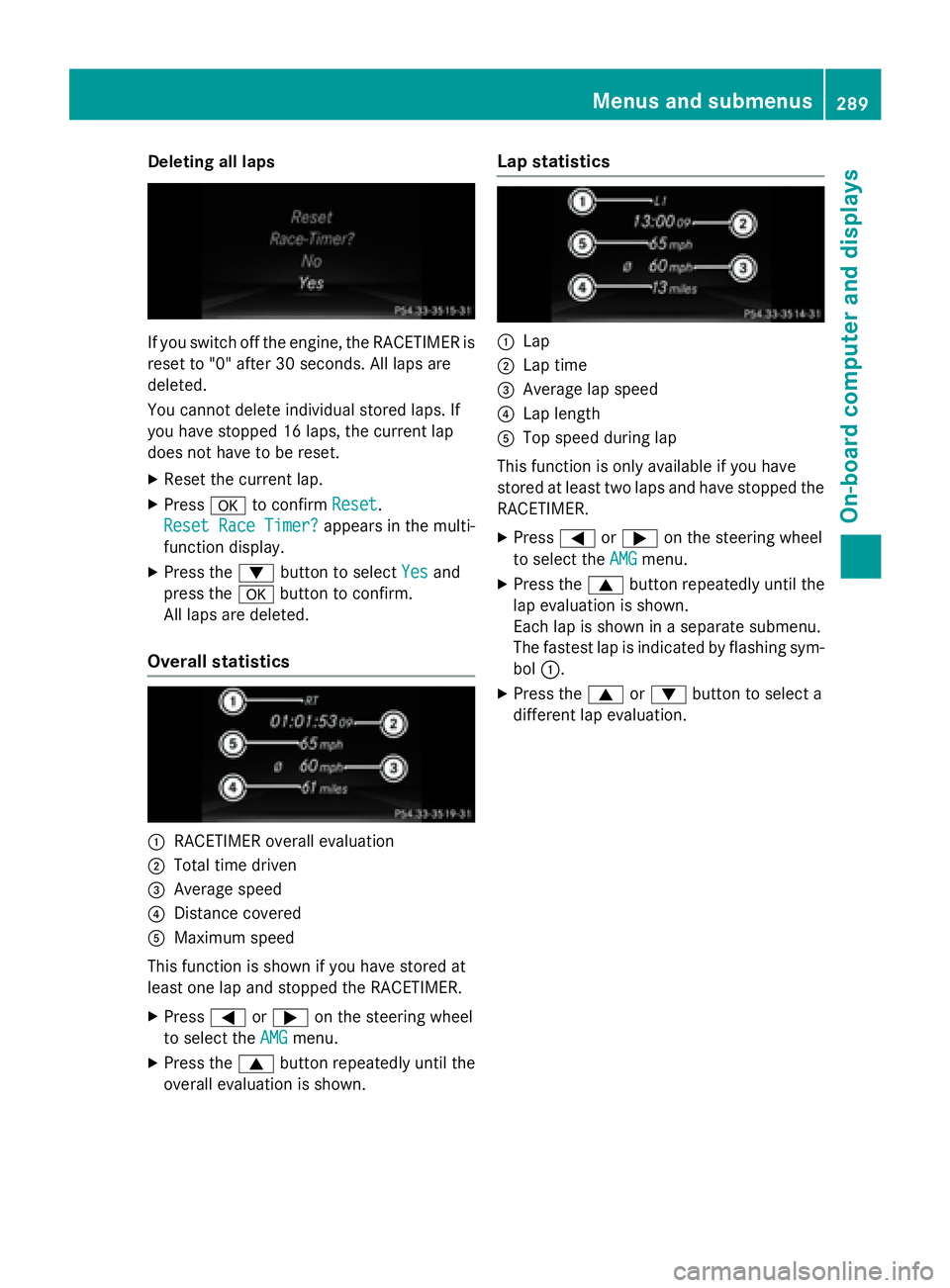
Deleting all lap s
If you switch of f th e engine, th e RACETIMER is
reset to "0" after 30 seconds. Al l laps are
deleted.
You canno t delete individual store d laps . If
you hav e stoppe d 16 laps , th e curren t lap
does no t hav e to be reset .X
Rese t th e curren t lap.X
Press �v to confirm Reset .
Reset Rac e Timer?
appears in th e multi-
function display. X
Press th e �d butto n to select Yes and
press th e �v butto n to confirm .
Al l laps are deleted.
Overall statistics
�C
RACETIMER overall evaluation�D
Total time driven�